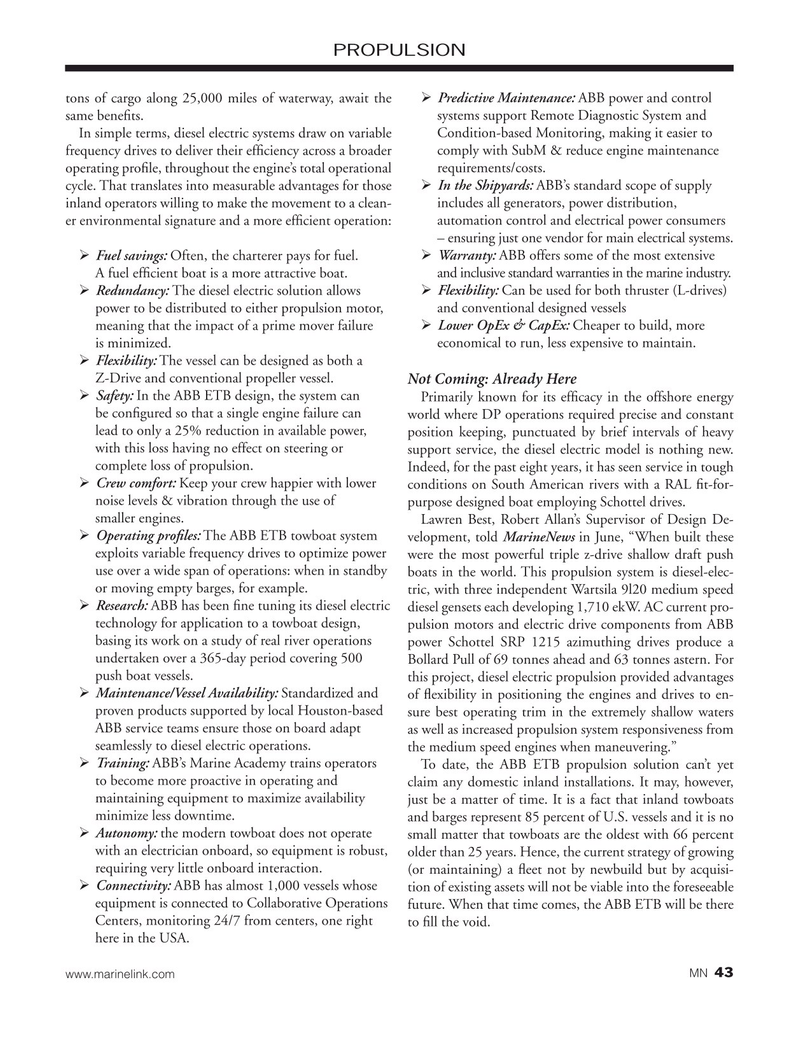
Page 43: of Marine News Magazine (July 2018)
Propulsion Technology
Read this page in Pdf, Flash or Html5 edition of July 2018 Marine News Magazine
PROPULSION tons of cargo along 25,000 miles of waterway, await the ¾Predictive Maintenance: ABB power and control same bene? ts. systems support Remote Diagnostic System and
In simple terms, diesel electric systems draw on variable Condition-based Monitoring, making it easier to frequency drives to deliver their ef? ciency across a broader comply with SubM & reduce engine maintenance operating pro? le, throughout the engine’s total operational requirements/costs. cycle. That translates into measurable advantages for those ¾In the Shipyards: ABB’s standard scope of supply inland operators willing to make the movement to a clean- includes all generators, power distribution, er environmental signature and a more ef? cient operation: automation control and electrical power consumers – ensuring just one vendor for main electrical systems.
¾Fuel savings: Often, the charterer pays for fuel. ¾Warranty: ABB offers some of the most extensive A fuel ef? cient boat is a more attractive boat. and inclusive standard warranties in the marine industry.
¾Redundancy: The diesel electric solution allows ¾Flexibility: Can be used for both thruster (L-drives) power to be distributed to either propulsion motor, and conventional designed vessels meaning that the impact of a prime mover failure ¾Lower OpEx & CapEx: Cheaper to build, more is minimized. economical to run, less expensive to maintain.
¾Flexibility: The vessel can be designed as both a Z-Drive and conventional propeller vessel.
Not Coming: Already Here ¾Safety: In the ABB ETB design, the system can Primarily known for its ef? cacy in the offshore energy be con? gured so that a single engine failure can world where DP operations required precise and constant lead to only a 25% reduction in available power, position keeping, punctuated by brief intervals of heavy with this loss having no effect on steering or support service, the diesel electric model is nothing new. complete loss of propulsion. Indeed, for the past eight years, it has seen service in tough ¾Crew comfort: Keep your crew happier with lower conditions on South American rivers with a RAL ? t-for- noise levels & vibration through the use of purpose designed boat employing Schottel drives.
smaller engines. Lawren Best, Robert Allan’s Supervisor of Design De- ¾Operating pro? les: The ABB ETB towboat system velopment, told MarineNews in June, “When built these exploits variable frequency drives to optimize power were the most powerful triple z-drive shallow draft push use over a wide span of operations: when in standby boats in the world. This propulsion system is diesel-elec- or moving empty barges, for example. tric, with three independent Wartsila 9l20 medium speed ¾Research: ABB has been ? ne tuning its diesel electric diesel gensets each developing 1,710 ekW. AC current pro- technology for application to a towboat design, pulsion motors and electric drive components from ABB basing its work on a study of real river operations power Schottel SRP 1215 azimuthing drives produce a undertaken over a 365-day period covering 500 Bollard Pull of 69 tonnes ahead and 63 tonnes astern. For push boat vessels. this project, diesel electric propulsion provided advantages ¾Maintenance/Vessel Availability: Standardized and of ? exibility in positioning the engines and drives to en- proven products supported by local Houston-based sure best operating trim in the extremely shallow waters ABB service teams ensure those on board adapt as well as increased propulsion system responsiveness from seamlessly to diesel electric operations. the medium speed engines when maneuvering.” ¾Training: ABB’s Marine Academy trains operators To date, the ABB ETB propulsion solution can’t yet to become more proactive in operating and claim any domestic inland installations. It may, however, maintaining equipment to maximize availability just be a matter of time. It is a fact that inland towboats minimize less downtime. and barges represent 85 percent of U.S. vessels and it is no ¾Autonomy: the modern towboat does not operate small matter that towboats are the oldest with 66 percent with an electrician onboard, so equipment is robust, older than 25 years. Hence, the current strategy of growing requiring very little onboard interaction. (or maintaining) a ? eet not by newbuild but by acquisi- ¾Connectivity: ABB has almost 1,000 vessels whose tion of existing assets will not be viable into the foreseeable equipment is connected to Collaborative Operations future. When that time comes, the ABB ETB will be there Centers, monitoring 24/7 from centers, one right to ? ll the void. here in the USA. 43 www.marinelink.com MN
MN July18 Layout 32-49.indd 43 MN July18 Layout 32-49.indd 43 6/19/2018 4:06:15 PM6/19/2018 4:06:15 PM

 42
42

 44
44
